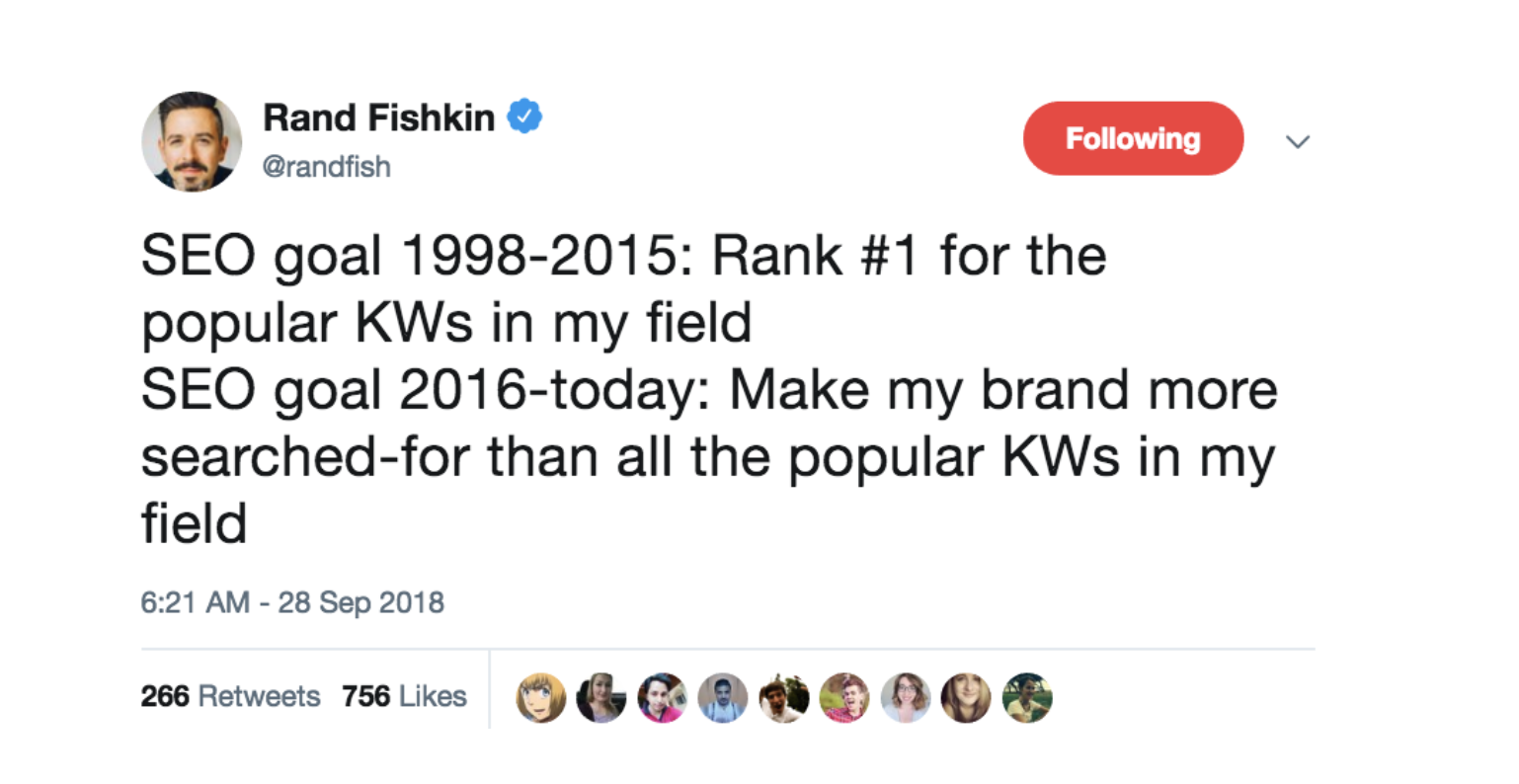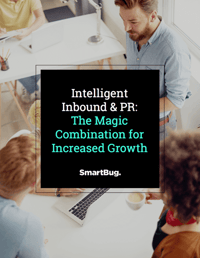
How to Improve Your Inbound Marketing Strategy with PR
October 30, 2018
Guest author Gaetano DiNardi is the director of demand generation at Nextiva, the leading all-in-one communications platform.
If public relations (PR) merely exists as an afterthought in your inbound marketing strategy, then you’re playing with a serious handicap.
In a world of digital distraction, smart brands deploy every effective means to catch, hold, monetize, and nurture the attention of their audiences. With customers in full control of the conversation, not doing so means relinquishing precious ground to competitors—and, even worse, steering down the path of irrelevance.
It’s simple: If I search for “sneaker cleaning tips,” I’m likely going to trust an article from Nike and disregard results from unknown or less prominent brands.
This tweet from Rand Fishkin pretty much sums it up:

That is why marketing budgets remain on the uptrend, and why every possible channel—from billboards to social media—overflows with messages aimed at captivating users.
Inbound marketing and PR are two effective tactics used by organizations to drive awareness, build trust, and bring audiences closer to a desired action such as a sign-up, subscription, or sale.
Inbound Marketing vs. PR
They sound similar, but although PR and inbound marketing can integrate together quite nicely, they each have a distinct heritage and focus.
Public relations focuses on keeping an individual or organization’s reputation favorable to the general public, especially to audiences interested in the brand, including industry players and observers, target markets, shareholders, and employees.
Inbound marketing is a technique for unobtrusively promoting a product or service with the ultimate goal of drawing potential and existing customers to a sale.
Although the two fields focus on different domains and are separated by at least a century of technological, cultural, and economic changes, both PR and inbound marketing aim to help generate leads and keep an organization’s pipeline of potential customers full and flowing.
Inbound marketing does so by strategically leveraging the following:
- Content (e.g., reports, blogs, articles, e-books, videos, surveys, newsletters)
- Social media
- Mobile apps/experiences
- Email outreach
- Website development and administration
- Marketing analytics
- Search engine optimization (SEO)
On the other hand, PR practitioners perform their function using a wide array of tools, including:
- Corporate communications (e.g., press releases, speeches, and public interviews)
- Thought leadership
- Media relations and industry networking
- Conference or event sponsorships
- Social responsibility campaigns (these technically consist of the field of corporate ethics but are a natural platform for PR)
- Organizational branding and culture
- Lobbying
- Crisis management
The Case for PR
For some digital marketers, public relations may seem fluffy.
Why would anyone even consider traditional press releases and community events when the team could focus instead on more needle-moving campaigns involving SEO, conversion rate optimization, and data analytics?
The answer is simple: PR remains relevant today and can deliver significant ROI via its digital-era iterations, such as influencer marketing, brand validation, increasing website domain authority, link building, and social media reputation.
Here are some facts and figures that build the case for PR:
- The PR field is rapidly expanding. Statista reported that global PR revenue will grow by nearly 40 percent from $14 billion in 2016 to $19.3 billion in 2020.
- More than 60 percent of advertisers plan to increase in-house PR staffing over the next five years, and 75 percent plan to increase overall PR spend during the same period.
- Nearly all (94 percent) practitioners who use influencer marketing confirm its efficacy, reporting that it can generate as much as 11x the ROI of traditional advertising. Influencer marketing can reportedly earn $6.50 for every dollar spent.
Inbound Marketing + PR = The Numbers You Dream About
Because it can demonstrably drive momentum and deliver the goods for marketing and sales campaigns, public relations should remain a staple in your inbound marketing toolset.
By combining PR and inbound marketing, you cover the entire spectrum of switches needed to keep organizations relevant and businesses humming. From brand awareness and admiration to product consumption and advocacy, PR and inbound marketing turn on all the green lights for a responsive, favorable, and sustained consumer behavior toward a brand.
Writing for The Muse, Human at the Helm Founder Alex Honeysett puts it even more succinctly:
“You can’t market without doing a little PR, and you can’t do PR without a little marketing … The end goals—selling products and making people love a company—are too intertwined: If your products are terrible, your company probably won’t be viewed favorably by the public, and if people aren’t connecting with your overall brand, they’re probably not going to buy your products.”

7 Easy PR Tactics to Boost Your Inbound Marketing Campaigns
1. Build content that is worthy of PR.
If content is king, then PR copy should have all the trappings and commanding presence of royalty. Because the way you communicate is nearly as important as what you are trying to say, content quality and impact—whether in simple blog posts or in groundbreaking industry reports—are non-negotiable. At the very least, pitching an article or post to a prestigious and quality-conscious media outlet will be a moonshot if you’re just offering fluffy trash. On this front, having a team of top-notch PR/marketing copywriters can be a huge competitive advantage.
2. Aim for thought leadership.
Think Apple, Mercedes-Benz, Disney, and Google. Your business may be far from achieving the status of these power brands, but you can start the journey by crafting, internalizing, and sharing industry insight worthy of thought leadership in your niche. Aim for practical and effective advice that demonstrates your genuine commitment to the success of your audiences. With such sustained efforts (delivered through blog articles, newsletters, or social media), you can steadily build trust not only among your target customers but in your entire ecosystem as well.
3. Don’t underestimate the press release.
Press releases seem so old school, but contrary to popular belief, the decades have barely dented their efficacy. When deployed strategically, press releases can drive significant traffic to your inbound marketing or sales assets (e.g., homepage, e-commerce site, social network page, and so on). To ensure success, just do your homework. Craft only high-quality, accurate, and compelling press releases (for a product launch, community event, joint venture, and so forth). News outlets will be more than happy to publish. Don’t forget to optimize the copy for online search.
4. Build meaningful media alliances.
Sometimes, knowing someone from an ad agency, news magazine, resource site, or trade publication is all you need to get your message across. Start and grow relationships with bloggers, content managers, editors, and journalists to support your PR and inbound marketing efforts. Build your case with these potential partners by providing value at touchpoints in their journeys as gatekeepers of information. Be responsible in implementing link-building and sharing arrangements with outlets and channels you want to partner with. Responsible use of social media will not only bolster these partnerships but also help ramp up lead generation.
5. Optimize for search and mobile.
Online search and mobile browsing are two activities more and more people are getting into. Because more of your target audience use online search and mobile, having dedicated resources to optimize these channels for your brand is imperative. An in-house SEO specialist and mobile-optimized web assets are indispensable resources in every marketing team looking to flourish in the digital economy. Adopting SEO best practices, such as content optimization, will help strengthen the impact of your PR messaging.
6. Leverage social media to your advantage.
Brands literally get elevated or destroyed overnight on social media. In good times, social media is among the best ways to get positive, action-inducing messages across. On bad days, when a brand crosses the line of public expectations, it can be an effective tool for damage control. In between, social media can help you:
- Build lasting communities where you can have meaningful conversations related to your brand
- Drive traffic to the messaging assets you want your audiences to see, or to the online/offline experiences you want them to have
- Spread your thought leadership content
- Share your corporate culture
7. Engage influencers.
Online capital is the new currency, with many internet influencers earning millions of dollars. Brands don’t mind footing the bill and are even planning to spend more on influencer engagement in the years ahead. In some sense, influencers of the digital age either serve as the domain experts partnering with PR specialists in the previous century or as the talent endorsers hired by ad agencies to promote products and services. Depending on your niche and branding, you can engage with either or both. One way to partner or build trust with influencers without breaking the bank is to offer real value (e.g., useful content) to their target audiences. Another (perhaps the best way) is to build a compelling product or service that influencers will be happy to personally use and share with their followers.
What's Next?
In an ideal world, inbound marketing and public relations play on the same team. They aim for the same ultimate goals and achieve targets by leveraging relationships and articulating a hyper-contextual message for each type of audience they serve. Working in sync, the two fields provide each other with the specialized resources each needs to drive, measure, and sustain success.
Properly executed, a unified PR and inbound marketing strategy can’t help but drive visibility, trust, and profitability.

About the author
Gaetano DiNardi is the Director of Demand Generation at Nextiva, the leading all-in-one communications platform. Outside of marketing - he is an accomplished music producer & songwriter. Read more articles by Gaetano DiNardi.







